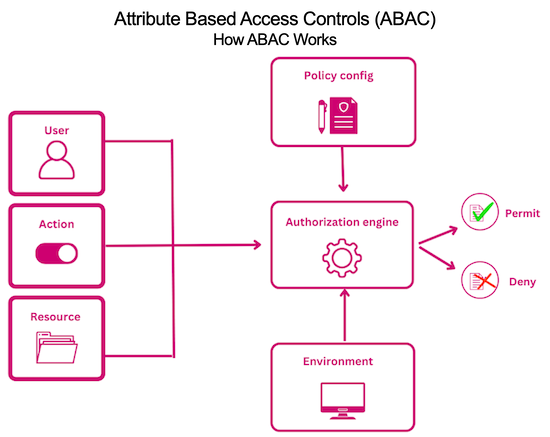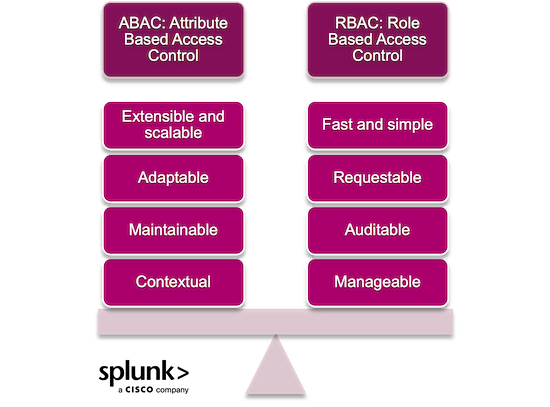RBAC vs. ABAC: Role-Based & Attribute-Based Access Control Compared

Preventing fraud and data breaches starts with controlling unauthorized access - This is the essence of access control. There are several approaches to access control — two of the most popular methods are:
- RBAC: Role-Based Access Control
- ABAC: Attribute-Based Access Control
How do they differ, and which fits your organization best? Let’s find out.
What is RBAC?
Prior to RBAC, access controlling often had to assign permissions to users individually. It’s not difficult to imagine that this process is cumbersome and error prone. RBAC groups people into predefined roles. How? Based on their common responsibilities.
Then, permissions are assigned to these roles. Not individual users. This centralized management of roles is less error-prone and easier to administer. It works better for large organizations than older methods.
Depending on the organizational needs, there are several ways RBAC can be implemented.
- Flat RBAC: Roles are directly assigned to users. Each role acts independently with no relationships between roles.
- Hierarchical RBAC: Roles are structured in a hierarchy where higher-level roles inherit permissions from lower-level roles.
- Constrained RBAC: Create Roles with clear Separation of Duties (SoD) in a way no single user can commit fraud. For example, a user who can create transactions has no permission to approve transactions.
What is ABAC?

ABAC introduces attributes to handle dynamic factors better while RBAC uses predefined roles. It’s difficult to manage and consider dynamic factors such as time, location, or device with predefined roles.
An attribute is a property or characteristic associated with a user, resource, action, or context, used to define and enforce access control policies. Then ABAC uses a combination of attributes to handle permissions with more fine-grained control.
Types of attributes
When using ABAC, understanding the types of attributes and their functions is a must. See below for types of attributes:
- User attributes: Attributes that describe the user who makes the request. Eg: Job title, Department, Project group.
- Resource attributes: Attributes that describe the resource being accessed. Eg: File type, Internal resources/public resources, Document type - invoice/contract.
- Action attributes: Attributes that describe the action the user wants to perform.
Eg: Read, Write, Delete. - Environment attributes: Attributes that provide further context to the access request.
Eg: Whether the request comes from the Office Network or Public Wi-Fi. Does the request occur during business hours or outside of it? Is the device a corporate one or an unknown one?
ABAC vs. RBAC: Advantages, differences, and limitations
So how do you decide which approach suits your organization most? I would say it doesn’t solely depend on security. It’s about balancing security, ease of management, and cost.

Advantages and limitations of RBAC
RBAC is widely used for a reason — it’s easier to implement and manage.
If an organization has structured role hierarchies, it reduces administrative costs. Why? Because roles simplify access management. Auditing is also straightforward, thanks to its fixed and predictable role-based permissions.
But what about its limitations? RBAC struggles with granular permissions. For example, you can’t restrict access to data during specific times. As organizational needs grow, new roles may need to be created frequently. It can get uncontrollable, especially in organizations with very complex architectures.
Advantages and limitations of ABAC
ABAC works better when it comes to creating specific and complex business rules using attributes.
It’s ideal for context-aware policies — like restricting access to data only during specific times, such as working hours. Another advantage? It’s easier to introduce new permissions by combining existing attributes rather than creating entirely new roles, as required in RBAC.
However, ABAC has its challenges too. It requires a heavy initial investment and expertise to define and manage attributes and policies. And what about auditing? It can be difficult due to the sheer number of attributes that may be involved.
When should you use ABAC and RBAC?
When to use RBAC or ABAC may depend on factors like the size of your organization and specific security requirements. Let’s consider the below use cases to gain an idea of which model best suits your needs.
- For startups or growing businesses that frequently onboard new employees, RBAC is an efficient choice. If we can assign predefined roles to new hires it simplifies the process and provides consistent access permissions.
- For small teams with a limited number of employees and files, RBAC is the best choice. For example, a local bakery with 10 staff members can easily implement an RBAC system. You can define the bakers as having access to inventory systems while cashiers manage point-of-sale data.
- Companies that need access based on specific times of the day can use ABAC. With ABAC you can keep sensitive documents or systems inaccessible outside office hours. For example, a retail business may restrict inventory management systems to working hours only and prevent unauthorized after-hours access.
- Creative businesses, such as advertising agencies, design studios, or game development companies, often can use ABAC. These companies might need to change the access to certain resources frequently. For example, designers may share concept files with marketers, but only the finance team can access billing documents. Therefore, ABAC suits well for their operations.
- In industries requiring regulatory compliance, ABAC provides the necessary granularity to meet strict access requirements. For example, financial institutions can use ABAC to enforce rules that restrict access to sensitive data based on location, time, and job role, by confirming that they adhere to security regulations like GDPR or PCI DSS.
Is RBAC or ABAC more secure?
ABAC can be considered generally more secure. It can provide more fine-grained access control because it uses attributes with specific capabilities. Thus, it provides somewhat multi-layer security compared to the single-layer security RBAC provides.
Also, RBAC is somewhat more vulnerable to bigger damage from attacks. For example, if a role has excessive permissions and an attacker gains access, they can exploit everything linked to that role.
Dealing with data breaches is also easier with ABAC. Tweaking and updating attributes (which have a smaller scope compared to roles) is easier than updating or creating new roles. This is why industries like finance and healthcare often lean toward ABAC. Its flexibility and capability to meet strict compliance requirements make it the better option for them.
Performance comparison of RBAC and ABAC
RBAC usually takes the lead here because of its simplicity. ABAC has a more complex process that involves evaluating multiple attributes like user details, resource type, and context (like time or location) in real-time, which can slow things down, especially as the number of users and policies grows.
When companies grow, RBAC tends to handle it well. However, if too many roles are added to cover unique situations a problem known as role explosion can occur and this can slow down the system. ABAC, while more flexible, can struggle with larger systems because of the increased computational load required to process so many attributes and policies.
Automation in RBAC vs ABAC
We mentioned earlier that when selecting an access control approach, ease of management must be considered. Handling access controls for large organizations manually is nearly an impossible task. Automation helps to speed up the process, reduces mistakes, and lowers the cost.
Which is easier to automate — RBAC or ABAC?
RBAC is easier to automate as it has a straightforward structure with predefined roles and permissions. However, automation alone cannot address the issue of "role explosion," which we mentioned earlier.
If you use ABAC, automation is often required, not a choice. As ABAC relies on dynamic attributes, managing them requires automation. If your organization requires dynamic and context-aware access control, ABAC with automation is the way to go.
By using tools that support the features you need, you can greatly simplify the automation process.
Combining ABAC and RBAC
Should it be either RBAC or ABAC? No, you can use them together.
Both ABAC and RBAC have limitations and strengths, which is why a hybrid model is worth considering. RBAC performs consistently and efficiently in managing roles and permissions within identity management systems like LDAP. However, challenges like role explosion—where too many roles are created to address edge cases—can make RBAC difficult to maintain and scale.
This is where ABAC complements RBAC. It adds a dynamic, attribute-based layer. A hybrid model combines the simplicity of RBAC with the flexibility of ABAC. For example, ABAC can address over-provisioning and separation of duties (SoD) violations by enforcing contextual security policies. Dynamic features like data masking can also be achieved by linking RBAC-defined roles with ABAC-driven conditions.
The future of RBAC and ABAC
Both RBAC and ABAC have a strong future. Yes, it’s true that ABAC is getting popular, but that doesn't mean RBAC is going away anytime soon.
- ABAC -> higher flexibility -> is suitable for complex organizations.
- RBAC -> simplicity -> is suitable for less complex organizations.
Then there are new models like Relationship-Based Access Control (ReBAC), which are also gaining traction. It provides access based on relationships between users and resources. We can expect these models to work alongside RBAC and ABAC to create more advanced security solutions in the future.
There has also been the rise of Zero Trust Architecture, which works on the principle, "Never trust, always verify." In this architecture, every request needs to be verified, regardless of whether it comes from the same origin—unlike RBAC, which requires one-time authentication.
See an error or have a suggestion? Please let us know by emailing splunkblogs@cisco.com.
This posting does not necessarily represent Splunk's position, strategies or opinion.
Related Articles
About Splunk
The world’s leading organizations rely on Splunk, a Cisco company, to continuously strengthen digital resilience with our unified security and observability platform, powered by industry-leading AI.
Our customers trust Splunk’s award-winning security and observability solutions to secure and improve the reliability of their complex digital environments, at any scale.


